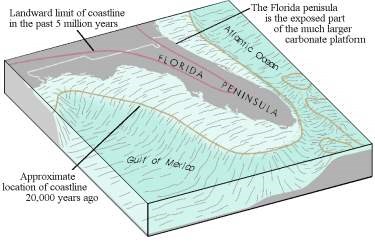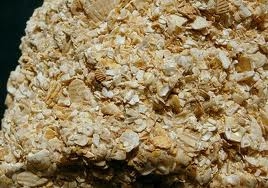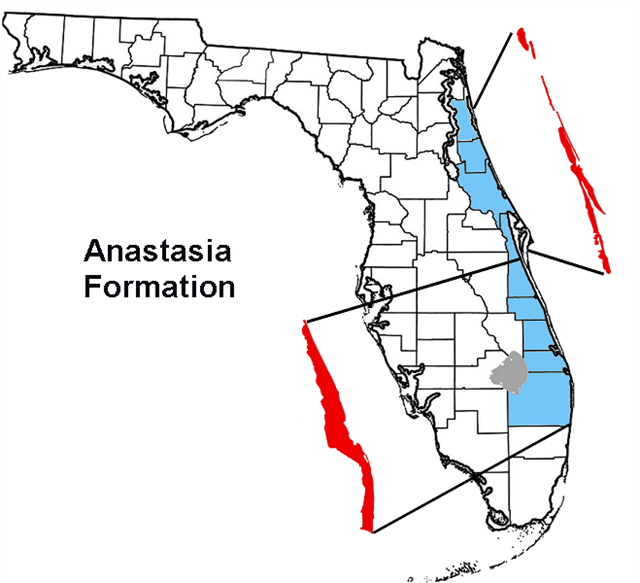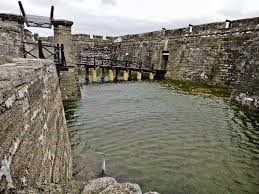This Earthcache is located with permission from Park Ranger Jill Jaworski at the Castillo de San Marcos National Monument. A special thank you her and to The Castillo Rangers who helped us write this earthcache.
The Castillo de San Marcos is open to the public from 8:45 AM to 5:15 pm every day of the year except December 25. (The ticket booth closes at 5:00 pm.) This earthcache is set up on the park grounds so you will not need to pay to enter The Castillo unless you would like to. Please do respect the Park grounds hours as they are closed from midnight until 5:30 am. If you want to park near The Castillo however, there is a parking fee.
The Castillo de San Marcos National Monument is the oldest masonry fort in the continental United States. This site, along with the entire state of Florida, lies on the Floridian Plateau which is 500 miles long. The Florida Plateau has existed for millions of years. During this time land on the plateau has been covered by seawater and exposed to dry land many times which has enabled marine and terrestrial life to form deposits.

What is Coquina?
Coquina is a type of sedimentary rough rock composed of deposits (small shells, coral, and fossils) that have been cemented together by calcite. For a sediment to be classified as coquina, the average size of the particles are 2 mm or greater in size. The word “coquina” means tiny shell in Spanish.

The Anastasia Formation
The coquina found at this spot is part of the Anastasia formation which dates as far back as 11.6 million years ago. The Anastasia formation is a narrow tract of rock along the East coast of Florida beginning near this location and extending Southward 200 miles to Boca Raton, Florida.

Although rock from the Anastasia formation is below your feet at this location, you cannot see it due to another layer of sedimentary deposits such as sand, mud, and vegetation covering it. However, looking at the walls of The Castillo de San Marcos you can see the Anastasia formation coquina rock (fossilized shells) used in the construction of the Fort.
Coquina: A Great Defense
The coquina used to build The Castillo de San Marcos was quarried from Anastasia Island which is the island seen South-East of this location. When first cut into squares, coquina rock is soft but as it becomes exposed to air, it dries out. After approximately 1 to 3 years, the coquina hardens but is still relatively soft. Because of coquina's softness at this location, cannon balls would sink into, rather than shatter or puncture, the walls of The Castillo de San Marcos.
Coquina Erosion of The Castillo de San Marcos
There are 3 main ways coquina is broken down at The Castillo de San Marcos: chemically, biologically, and by humans.
Chemically
Over time, acid rain slowly dissolves the calcite found in coquina that cements the shells, coral, and fossil together. As the calcite is dissolved, the deposits become closer to the surface and the rock becomes rougher and sometimes pits. Large blocks of coquina also become more round as a result of being broken down chemically.

Biologically
Coquina rock has the ability to absorb large amounts of water. This absorption of water makes the surface of the coquina constantly damp, which allows plants to grow on the rock easily. Lichen and moss are the quickest plants to grow on coquina. Some lichens release acid that reacts with the stone and causes the same calcite breakdown as acid rain.

Human Impacts
In 1938, The Castillo de San Marcos caretakers filled the moat around the fort with seawater to make it more realistic. In 1996, the National Park Service discovered that the Spanish actually only filled the moat when it was under attack. The effect of the water being in the moat for so long eroded and cracked a lot of the coquina on the edges of the fort.

Visitors to The Castillo de San Marcos also add to the erosion of the coquina rock due to walking on and touching the rock. The National Park Service sometimes has to repair the coquina at the fort to make sure the structure is strong and secure. Every 7-10 days, National Park Service staff recover approximately 5 gallons of eroded coquina and plaster from natural and visitor impacts.
Now it is time for the questions. To get credit for the cache, please answer the questions below. When answering the questions do your best. It is more important that you learn a new concept about our earth and can apply your knowledge, rather than have a precise answer.
Questions:
1- At the coordinates you will find a small wall. What would you say is the main type of erosion that has broken down this small coquina rock wall (chemical, biological, or by humans)? Give your reasons why.
2- While standing at the coordinates you can see the scuppers (water drain pipes) coming out from the fort. What type of erosion is happening beneath the drain pipes (chemical, biological, or by humans)?
3-At the time of your visit how many drain pipes (give the actual #) on this entire North wall have this type of erosion?
4- What do you think is the biggest threat is to the overall stability of the coquina rock at The Castillo de San Marcos?
Thank you for visiting this earthcache. Please send your answers to the above questions to the cache owner. In your "found it" log feel free to write about your experience, but don't include the earthcache answers. Thanks and we hope you enjoy the beautiful Castillo de San Marcos!

Sources:
http://www.nps.gov/casa/index.htm
http://www.nature.nps.gov/geology/inventory/publications/s_summaries/CASA_gri_scoping_summary_2009-0807.pdf
http://en.wikipedia.org/wiki/Geology_of_Florida
http://www.geologicallocations.com/states/florida.htm
http://www.dep.state.fl.us/geology/geologictopics/rocks/time_scale.htm
http://en.wikipedia.org/wiki/Coquina
http://uwf.edu/fpan/coquinaqueries/lessons/10/Lesson10.pdf